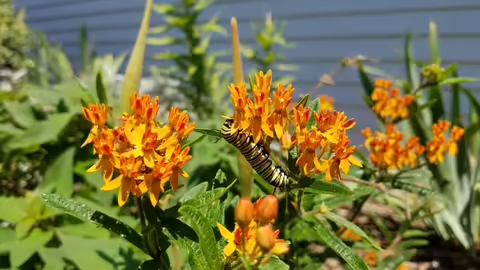Monarch butterflies are beautiful and their migration journey is inspiring. Monarchs need milkweeds because they MUST lay their eggs on milkweed leaves. It’s the only food the larva can eat. The caterpillars absorb toxins from milkweed plants into their bodies. The toxins will sicken birds, lizards, and mammals, but predators like wasps and spiders are immune to them.
At the Dana-Thomas House Cottage Butterfly Garden seven varieties of native milkweed (Asclepias) were planted in 2014. In 2019, only Common Milkweed remained. Wrong site location or crowding may have caused the other milkweed plants to die out. There are twenty-four species of milkweed native to a variety of habitats in Illinois. Here is information about seven species native to Illinois.
Asclepias syriaca, Common Milkweed, is a robust plant growing up to 5 feet tall. It is found in old fields, pastures, degraded prairie, and along roadsides. The flowers are in large rounded clusters at the tops of the stems and in the upper leaf axils. Each dark pink flower is about .25 inches across. The plant blooms May through August. The fruit pods are up to 4 inches long. Give common milkweed plenty of space to grow as it aggressively spreads by underground rhizomes.
Asclepias sullivantii, Prairie Milkweed, is found in moist prairies in the northern part of the state. It grows about 3 feet tall and produces dark pink flowers. There are from one to several flower clusters near the top of each stem, blooming in June and July.
Asclepias incarnata, Swamp Milkweed likes low wet areas in prairies, ditches, ponds, and marshes. It can grow up to 5 feet tall. It has narrower leaves than Common and Prairie Milkweed. The dark pink blooms appear June through August.
Asclepias purpurascens, Purple Milkweed, is found in prairies, open woods, and thickets throughout the state. It produces purple flowers from May through July. The flowers are in large rounded clusters at the top of the stem.
Asclepias verticillata, Whorled Milkweed is a slender single-stemmed plant with whorled leaves that grows to 18 inches tall. The white to pink flowers appear in April and May. It grows in dry or rocky open woods in the southern part of the state.
Asclepias exaltata, Poke Milkweed, got its name because the leaves resemble those of the pokeweed plant. It is an uncommon plant found in open woodlands, rich mesic woods, and sandy woodlands and is considered an indicator of good quality woodland habitat. This upright plant grows to 5 feet tall. It blooms in June, producing loose clusters of drooping, starry, white flowers with swept-back green sepals. The flowers may have a tinge of lavender.
Asclepias tuberosa, Butterfly Weed, is a milkweed that can be found at many garden centers. It grows to 2.5 feet tall and has flowers that range from orange to pale yellow. The leaves are narrow. It grows in prairies, dry open woods, savannas, old fields, and roadsides.
Milkweeds have a long medical history, used by both Native American tribes and settlers. During World War II, the milky latex was tested as a rubber substitute, and the seed pods were collected by school children as part of the war effort. The fluffy material inside was used in life vest when there was a shortage of kapok, the cottony material surrounding the seeds of the Ceiba tree. The Japanese controlled the area that produced much of the kapok supply.
Article written by Susan Shaw, University of Illinois Extension master naturalist volunteer.
Sources:
For more information about the species native to Illinois visit, Illinois Department of Natural Resources, Illinois Milkweeds, https://www2.illinois.gov/dnr/publications/documents/00000835.pdf
Illinois Wildflowers by Don Kurz, copyright 2004 and 2014 by Tim Ernst Publishing
Prairie Plants of Illinois by John W. Voigt and Robert H. Mohlenbrock, printed by the State of Illinois Department of Conservation
Chicago Botanical Garden web site plant finder
